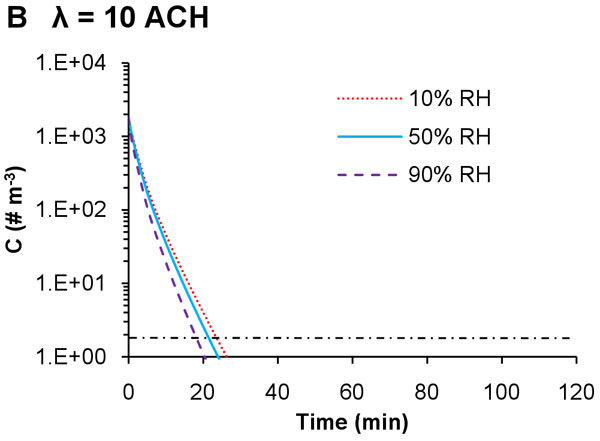Published Jun 2011 | PLoS ONE, 1 June 2011 | Volume 6 | Issue 6 | e21481
Dynamics of airborne influenza A viruses indoors and dependence on humidity
Yang W, Marr LC
Abstract
There is mounting evidence that the aerosol transmission route plays a significant role in the spread of influenza in temperate regions and that the efficiency of this route depends on humidity.
Nevertheless, the precise mechanisms by which humidity might influence transmissibility via the aerosol route have not been elucidated.
We hypothesize that airborne concentrations of infectious influenza A viruses (IAVs) vary with humidity through its influence on virus inactivation rate and respiratory droplet size.
To gain insight into the mechanisms by which humidity might influence aerosol transmission, we modeled the size distribution and dynamics of IAVs emitted from a cough in typical residential and public settings over a relative humidity (RH) range of 10–90%.
The model incorporates the size transformation of virus-containing droplets due to evaporation and then removal by gravitational settling, ventilation, and virus inactivation. The predicted concentration of infectious IAVs in air is 2.4 times higher at 10%RH than at 90%RH after 10 min in a residential setting, and this ratio grows over time.
Settling is important for removal of large droplets containing large amounts of IAVs, while ventilation and inactivation are relatively more important for removal of IAVs associated with droplets <5 µm. The inactivation rate increases linearly with RH; at the highest RH, inactivation can remove up to 28% of IAVs in 10 min.
Humidity is an important variable in aerosol transmission of IAVs because it both induces droplet size transformation and affects IAV inactivation rates. Our model advances a mechanistic understanding of the aerosol transmission route, and results complement recent studies on the relationship between humidity and influenza's seasonality.
Conclusion
Maintaining a high indoor RH and ventilation rate may help reduce chances of IAV infection.
Scientific studies main menu

Dry air and airborne infection
Low humidity acts as a conduit for viruses and airborne bacteria to disperse and travel around a building and threaten all occupants.
Read moreDry air and our airway defence system
Low humidity dries our mucous membranes and inhibits our body's natural defence against airborne germs, viruses and bacteria.
Read moreDry air and our eyes
Low humidity dries our eyes' precorneal tear film making us prone to eye irritations and contact lens discomfort.
Read moreDry air and our skin
Low humidity dries the outer layer of our skin leading to itchiness, cracking and dermatological problems.
Read more
















